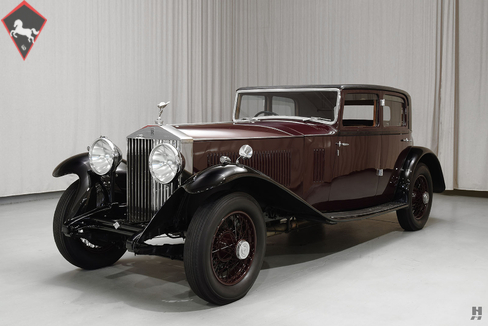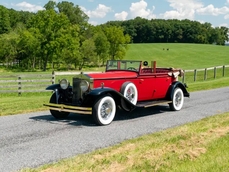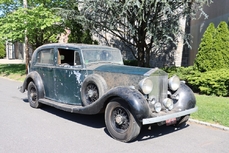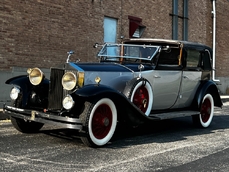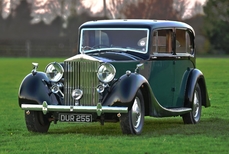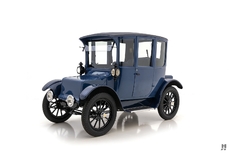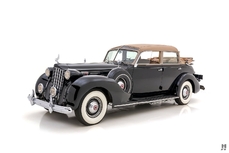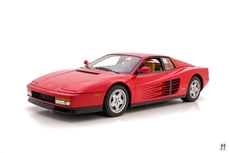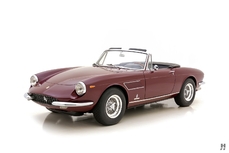Rolls-Royce Phantom II Sports Saloon 1932
Allgemeine Beschreibung :
As the last Rolls-Royce designed under the direct supervision of Sir Henry Royce, the Phantom II Continental is the ultimate and most desirable iteration of the Phantom range. As its name would suggest, the Continental was designed for high-speed touring across Europe, and in ultimate spec, was capable of approaching 100mph. What set the Continental apart from the standard range was namely the shortened chassis with stiffer, five-leaf springs to handle the rigors of high-performance touring and a series of sporting bodies offered by select coachbuilders.
The standard Phantom II shared very little in common with its predecessor (Phantom I) beyond the bore and stroke dimensions of the 7,668cc inline six-cylinder engine. Engineers made a great deal of progress within the big six; adding a cross flow cylinder head, separate inlet ports, improved exhaust manifold and a bump in compression allowing for an additional 20hp. The driveline was also improved with modifications to the gearbox and clutch and the addition of a Hotchkiss drive layout for the hypoid rear axle which allowed for a lower floor line. This of course delighted coachbuilders who could now fit lower, sleeker bodywork and the addition of the short chassis Continental allowed coachbuilders to showcase their most sporting designs. Performance was exceptional for a car of this size, and sales proved strong considering the price, with 281 of the total Phantom II production of 1,767 units leaving the works in Continental specification.
Chassis number 80MS was originally ordered by the respected dealer Jack Barclay in 1932. It was sent to directly to H.J. Mulliner where it received the handsome sports saloon coachwork it wears today. On November 21, 1932, 80MS had completed testing and was delivered three days later to E.M. Thomas and his famous motor-racing wife, Jill (Scott) Thomas. The Thomas’ were well known in motor racing circles; E.M. Thomas was a regular competitor at Brooklands, though rather uncharacteristically for the time, it was his wife who was truly the hardcore racer. She had been formerly married to “Bentley Boy” W.B. Scott and was the first woman to lap Brooklands at over 120mph. She won multiple races and held several 500km and 500 mile records. As such, she was the first ever woman elected to the storied BRDC.
According to factory notes, Mr. Thomas insisted special attention be paid to the brakes on his new Rolls-Royce. We can only assume that this wonderful Phantom II was enjoyed to its fullest by its enthusiastic original owners. In 1938, 80MS passed to Mr. Angus Fletcher, who is believed to have retained the car through the War. It then passed to Mr. John Lewis who kept the car through 1962 when it appears to have made its way to the United States. In 1989, following long-term ownership, the car was handed over to Lyle Reider of British Marque Auto in Pennsylvania who carried out a bare metal respray, re-wiring, and cosmetic restoration. In conjunction, John Dennison performed a full engine rebuild. The most recent owner acquired the car in 2003 who has continually maintained it in excellent mechanical order, using it regularly on tours, events and rallies.
Today, 80MS (engine number WO85) remains in very fine order, showing just a bit of patina from regular use. The crisp and attractive H.J. Mulliner coachwork presents very well with burgundy main body over black fenders and a black upholstered roof. The paint is in good order, showing some signs of use here and there, but remaining quite attractive since the respray was completed. Maroon wire wheels wear blackwall tires that are an ideal match for the sporting coachwork. A single rear mount spare keeps the body sides clean, fully accentuating the sweeping line of the fenders. This is the original body to 80MS, and a photo of the car is featured in Raymond Gentile’s book, “The Rolls-Royce Phantom II Continental” (p156).
The cabin has been retrimmed in attractive brown leather with brown Wilton carpeting. The seats appear lovingly broken-in and the detailing is unfussy and down to business. Wood trim on the door caps and dash is in fine order. Under the bonnet, the 7.7 liter inline six presents beautifully, again showing minor signs of use but never abuse or neglect. Fittings and hardware are largely correct with a few minor accommodations for modernity such as the hose clamps and drive belt.
The Phantom II Continental was designed from day one as a driver’s car with cross continent touring its main charge. With its very intriguing early history, fantastic Mulliner coachwork and well-sorted mechanical condition, we are confident this fine example will continue to bring much enjoyment to its next keeper.
http://hymanltd.com/vehicles/5843-1932-rolls-royce-phantom-ii-sports-saloon/
1932 Rolls-Royce Phantom II Sports Saloon is listed verkauft on ClassicDigest in St. Louis by Mark Hyman for Preis nicht verfügbar.
Fakten der Auto
Karosserietyp : Auto Marke : Rolls-Royce Modell : Phantom II Ausführung : Sports Saloon Hubraum : 0.0 Modelljahr : 1932 Karosstyp : Sedan Lage : Missouri
Verkauft
Angaben Zum Verkäufer
Verkauft
People who viewed this Rolls-Royce Phantom II also viewed similar Rolls-Royce listed at ClassicDigest
Other cars listed for sale by this dealer
über Rolls-Royce
Nun, meine Damen und Herren, heute tauchen wir ein in die glanzvolle Geschichte einer Marke, die immer das ganz Wesen britischen Luxus und Handwerkskunst verkörpert hat - Rolls-Royce.Unsere Geschichte beginnt zu Beginn des 20. Jahrhunderts, als zwei Visionäre, Charles Rolls und Henry Royce, beschlossen, sich zusammenzuschließen. Im Jahr 1904 wurde der allererste Rolls-Royce geboren, der Rolls-Royce 10 hp. Es war ein bescheidener Anfang für ein Unternehmen, das die Automobil-Exzellenz neu definieren würde.
Aber es war erst 1907, dass Rolls-Royce wirklich seinen Stempel aufdrückte, mit der Einführung des Silver Ghost. Er wurde als das "Beste Auto der Welt" gefeiert und setzte den Goldstandard für Luxusautos. Mit seinem flüsterleisen Motor und seiner exquisiten Handwerkskunst war er ein Statement von Opulenz und Raffinesse.
Die 1920er Jahre brachten uns den Rolls-Royce Phantom I, ein Ikone seiner Zeit. Es war der erste Rolls-Royce mit einem 6-Zylinder-Motor und legte den Grundstein für die legendäre Phantom-Reihe. Dies war die Ära, in der die Maharadschas von Indien maßgefertigte Rolls-Royces in Auftrag gaben, die nichts weniger als automobilen Palästen entsprachen.
Schnell vorwärts in die Nachkriegsjahre, und wir haben den Silver Cloud, ein Symbol für den britischen Optimismus der Nachkriegszeit. Der Silver Cloud verkörperte Eleganz, mit seinen fließenden Linien und handgefertigten Interieurs. Er war die Wahl von Königen, Prominenten und Industriekapitänen.
Aber wenn wir über das Epizentrum des Rolls-Royce-Luxus sprechen, dann ist es der Rolls-Royce Phantom VI, der uns von 1968 bis 1991 begleitete. Dies war ein Auto, das die Aussage traf, dass "wenn Sie nach dem Preis fragen müssen, können Sie es sich nicht leisten." Anpassung war das Stichwort, und der Phantom VI war eine Leinwand für die weltweit Wohlhabendsten, um ihren einzigartigen Geschmack auszudrücken.
Nun, es ist unmöglich, über Rolls-Royce zu sprechen, ohne den Rolls-Royce Corniche zu erwähnen. Produziert von 1971 bis 1995, handelte es sich um eine Cabriolet- und Coupé-Version des Silver Shadow. Der Corniche war der Inbegriff des Grand Touring, ein Auto für diejenigen, die den Kontinent in absolutem Luxus durchqueren wollten.
Aber, ach, selbst die Mächtigsten müssen ihren Niedergang erleben, und Rolls-Royce war keine Ausnahme. Das Unternehmen durchlief in den 1970er und 80er Jahren finanzielle Turbulenzen, was zur Übernahme durch Vickers plc führte. Dann kam die umstrittene Eigentümerschaft von BMW und Volkswagen, die die Enthusiasten spaltete.
Rolls-Royce erlangte unter BMW-Besitz wieder Boden, und das neue Jahrtausend brachte uns den Rolls-Royce Phantom VII, eine Rückkehr zu den Wurzeln des Unternehmens für kompromisslosen Luxus. Der Phantom VII war ein Zeugnis für britische Ingenieurskunst und Handwerkskunst.
Und das, meine Damen und Herren, bringt uns auf den heutigen Tag. Rolls-Royce produziert weiterhin einige der opulentesten, maßgeschneiderten Fahrzeuge auf dem Planeten, ein Symbol für die britische Imperium, das mit der Zeit nicht verblasst ist. Der Geist von Sir Henry Royce und Charles Rolls lebt in jedem Auto weiter, das die Spirit of Ecstasy trägt, ein Zeugnis für das anhaltende Erbe der britischen Automobil-Exzellenz.
